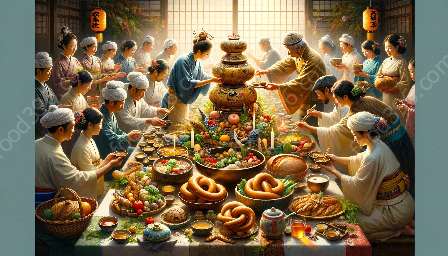Food is not just sustenance; it is also a reflection of culture, tradition, and history. Across different cultures, specific ingredients and dishes carry symbolic meanings and play integral roles in food rituals and practices. Understanding the significance of these culinary symbols provides a deeper insight into the food culture and history of a community.
Symbolism and Food Rituals
Food rituals often incorporate symbolic ingredients and dishes to mark important events, ceremonies, and celebrations. These foods are imbued with meaning and serve as more than just nourishment—they carry messages of prosperity, unity, and spiritual significance.
Examples of Symbolic Ingredients and Dishes
Let's delve into the symbolic meanings of specific ingredients and dishes across various cultures:
- Rice: In many Asian cultures, rice symbolizes fertility, abundance, and prosperity. It is a staple ingredient in numerous rituals and ceremonies, signifying wealth and well-being.
- Pomegranate: The pomegranate holds symbolic importance in Mediterranean and Middle Eastern cultures, representing fertility, abundance, and good fortune. It often appears in wedding feasts and New Year's celebrations.
- Unleavened Bread: Commonly associated with religious symbolism in Christianity and Judaism, unleavened bread represents purity, humility, and the Exodus story. It features prominently in Passover and the Eucharist.
- Dragonfruit: In some East Asian cultures, the dragonfruit symbolizes prosperity, good luck, and auspicious blessings. It is often present in festive gatherings and ceremonies.
Imbued with Symbolism
These examples illustrate how certain ingredients and dishes are imbued with symbolism, adding layers of meaning to culinary experiences and traditions.
Food Culture and History
Understanding the symbolic meaning of ingredients and dishes also provides insights into the rich tapestry of food culture and history. It reveals the interwoven nature of culinary traditions and societal beliefs, showcasing the depth of cultural heritage.
Historical Significance
The symbolic use of ingredients and dishes often traces back to historical events, religious practices, and folk traditions. By exploring the historical contexts of these symbols, we gain a deeper appreciation for the cultural evolution of food.
Traditional Recipes
Many traditional recipes incorporate symbolic ingredients, allowing individuals to connect with their cultural roots and ancestral heritage. Through these recipes, the history and symbolism of certain foods are preserved and passed down through generations.
The Allure of Symbolic Foods
Symbolic ingredients and dishes add an air of intrigue and fascination to the culinary world. They invite us to explore the intricate web of meanings woven into the fabric of food culture and history.
Continued Relevance
Despite the passage of time, the symbolic significance of certain ingredients and dishes persists, maintaining their relevance in contemporary food practices. They serve as cultural touchstones, bridging the past and the present.
Celebrating Diversity
By uncovering the symbolic meanings of various ingredients and dishes, we celebrate the diversity of food culture and recognize the interconnectedness of global culinary traditions.

